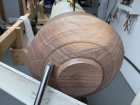This one has me stumped. I have a 4 inch thick piece of walnut that had air dried for 30 years. It had a crack in it which I filled with epoxy prior to turning. When I turn through the area containing the epoxy, 1 or 2 passes actually dulls the tool. I mean, it’s Dull and it stops cutting entirely! There’s nothing wrong with the gouge, it’s a new Mastercut 1/2 inch bowl gouge from Oneway with M42 steel. The gouge will cut cleanly through an entire bowl from the same piece of walnut and even from non-epoxied areas of the same bowl blank. But when it cuts into the epoxied area, it’s dull after one cut. I used Chill brand epoxy with a 24 hour cure time. Anyone have any idea what’s happening?


